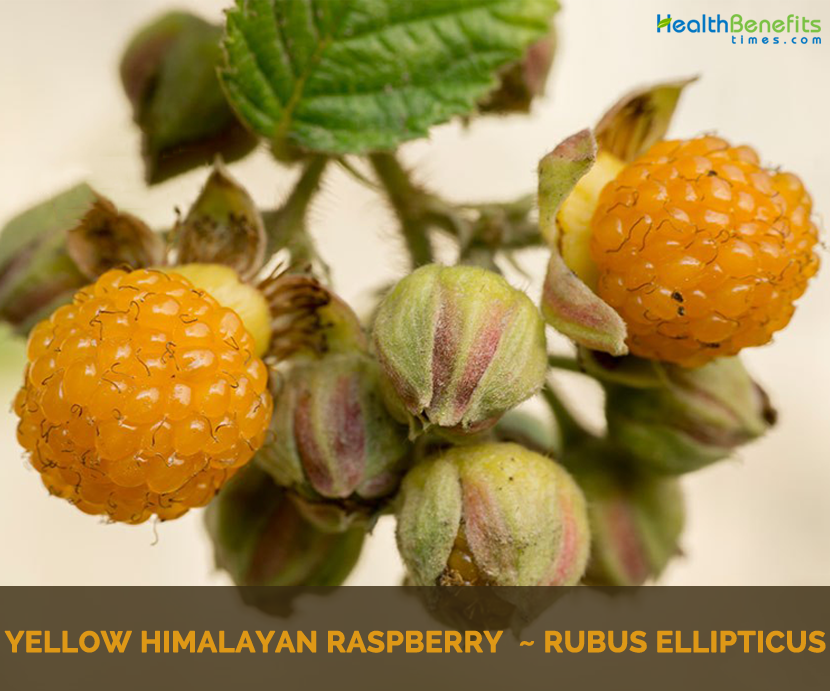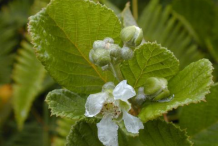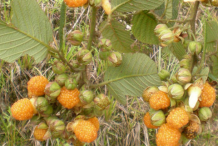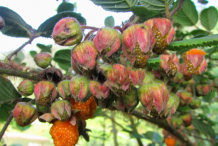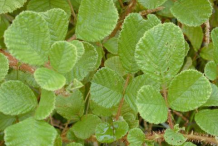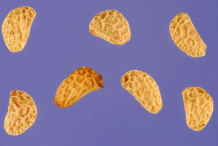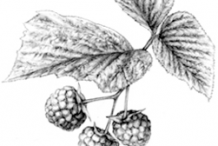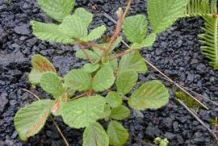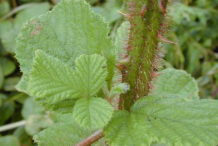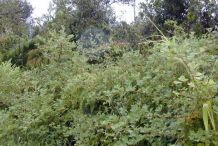In Hawai’i it is considered a weed or naturalized alien invasive plant although it was initially deliberately introduced in 1961. It is also listed as one of the 100 of the world’s worst invasive alien species’ in the Global Invasive Species Database (GISD) of the Invasive Species Specialist Group (ISSG). The plant is harvested from the wild for local use as a food and a medicine. The fruit is also sold in local markets in the Himalayas. The plant is grown both as a fruit crop and an ornamental in a variety of places, including Florida, Jamaica, Puerto Rico and California
Plant Description
Yellow Himalayan raspberry is a stout, weakly climbing, and evergreen shrub producing a bunch of stout, heavily armed, upright, biennial stems from a woody rootstock. The plant usually grows up to 4.5 meters, or about 12 feet long. The stems only produce leaves, and do not flower, in their first year of growth, forming flowering branches in their second year and then dying after fruiting. The plant can rapidly form tall, dense thickets. Branchlets are purplish brown or brownish, pubescent, with sparse, curved prickles and dense, purplish brown bristles or glandular hairs. The plant is normally found growing in slopes, Montana valleys, sparse forests, thickets, roadsides, in open canopy forests, the deep shade of rainforests and pastureland as well as waste land and agricultural land, and mostly where land has been disturbed by feral pigs.
Leaves
Leaves are trifoliate, elliptic, or obovate and toothed with long bristles. Thick leaves are about 3-4 inches long and 2-3 inches wide. Underside of the leaves is lighter than the upper surface and is covered with downy hairs.
Flower & Fruit
Flowers are small short, white, and have five petals and grow in clusters, and blooms in the Himalayas between the months of February and April. Flower has both male and female sex part and is normally pollinated by insects. The flower later changes into aggregate fruit that is sub globose, approximately 1 cm in diameter, glabrous or drupelets pubescent at apex; Pyrenees are triangular-ovoid and densely rugulose. Fruit is golden yellow as they mature. It is sweet to the taste, though it is not commonly collected for domestic use. The fruit perishes quickly after plucking from the thorny bush.
Bark of the plant is used for medical reasons in Tibetan villages, mostly as a renal tonic and an antidiuretic; its juices can also be used to treat coughs, fevers, colic and sore throat. The plant can also be used to make a bluish-purple dye.
History
The golden Himalayan raspberry’s origin is in the temperate Himalayas region, and is native to native of south-east Asia, found in the Himalayas from Pakistan to Nepal to southern China, as well as Bhutan, Burma, India, Myanmar, Philippines, Sri Lanka and Thailand. It has been introduced to several places but is listed as invasive only in the Hawaiian Islands so far, having become established on Hawai’i and been found in several places on Maui. It has become recognized in some parts of the Andes mountain chain in South America where it may become a problem. It is spread through cultivation. It is often found in Pine forests of the region.
The golden Himalayan raspberry can be found in mesic or wet forests, and have adapted to be able to live in complete shade and in full sun exposure. As with other Rubus species, its seeds are readily distributed by birds. It can also propagate, or asexual reproduction, itself through cutting. It can grow in open fields or in canopies of moist forests.
Traditional uses and benefits of Yellow Himalayan raspberry
- Plant is astringent and febrifuge.
- Decoction of the root, combined with Girardinia diversifolia root and the bark of Lagerstroemia parviflora, is used in the treatment of fevers.
- Juice of the root is used in the treatment of fevers, gastric troubles, diarrhea and dysentery.
- Paste of the roots is applied externally to wounds.
- Both the roots and the young shoots are considered to be a good treatment for colic.
- Leaf buds, combined with Centella asiatica and Cynodon dactylon, are pounded to a juice and used in the treatment of peptic ulcers.
- Juice of the fruit is used in the treatment of fever, colic, coughs and sore throat.
- Inner bark is used in Tibetan medicine, it is said to have a sweet and sour flavor plus a heating potency.
- It is used in the treatment of weakening of the senses, vaginal/seminal discharge, polyuria and micturition during sleep.
- Bark from this plant is used for medical reasons in Tibetan villages, mainly as a renal tonic and an antidiuretic.
- Juices can also be used to treat coughs, fevers, colic and sore throat.
- Its roots are used to treat stomach pain and headaches, and its fruits are used to treat indigestion in Sikkim.
- Eating Himalayan raspberries can help you deal with common cold and sore throat.
- Inner bark of this shrub has been used as a kidney tonic.
- Juice extracted from the roots of this shrub has been found to be useful in treating fevers and gastric problems and diarrhea.
- Create a paste of the roots and it can be used to speed up healing of injuries.
- It is extensively used for treating menstrual disorders.
- Rubus species are used in folk medicine such as diabetes mellitus, inflammatory disorders and ulcers.
- Gargling with leaves decoction is beneficial for mouth and throat disorders.
- 15-20 ml Leaf decoction is beneficial for stomach related disorders.
- 15-20 ml root decoction is also beneficial for abdominal
- Leaf decoction is also beneficial for abdominal pain.
- 3-5 g root bark decoction is beneficial for Jaundice.
- Paste prepared from its seeds when taken with milk is beneficial for urinary disorders.
- Leaf juice when applied is beneficial for skin disorders.
- Paste prepared from leaves makes your skin bright and glowing.
- Yellow Himalayan raspberry’s syrup is beneficial for fever.
- Root decoction is also beneficial for fever.
Ayurvedic Health Benefits of Yellow Himalayan Raspberry
- Diarrhea: Prepare a juice of Yellow Himalayan raspberry roots. Take it twice a day.
- Fever: Boil 10 g of Yellow Himalayan raspberry root in half liter of water. Boil it till the water remains half. Have quarter twice a day.
- Dysentery: Take Yellow Himalayan raspberry root and Brucea javanica fruit powder with water two times a day.
Other Facts
- It is widely grown as an ornamental in tropical climates.
- A purple to dull blue dye is obtained from the fruit.
- The plant is grown to deter soil erosion and is good for soil conservation.
References:
https://www.itis.gov/servlet/SingleRpt/SingleRpt?search_topic=TSN&search_value=504846#null
http://www.hear.org/pier/species/rubus_ellipticus.htm
https://www.cabi.org/isc/datasheet/47994
https://plants.usda.gov/core/profile?symbol=RUEL3
http://www.theplantlist.org/tpl1.1/record/rjp-3254
https://www.pfaf.org/user/Plant.aspx?LatinName=Rubus+ellipticus
https://www.plantwise.org/KnowledgeBank/Datasheet.aspx?dsid=47994
https://en.wikipedia.org/wiki/Rubus_ellipticus
https://indiabiodiversity.org/species/show/231023
http://www.iucngisd.org/gisd/species.php?sc=79
http://www.actforlibraries.org/invasive-alien-species-yellow-himalayan-raspberry/
https://wikivividly.com/wiki/Rubus_ellipticus
Comments
| Yellow himalayan raspberry Quick Facts | |
|---|---|
| Name: | Yellow himalayan raspberry |
| Scientific Name: | Rubus ellipticus |
| Origin | South Asia |
| Colors | Golden yellow |
| Shapes | Aggregate fruit, sub globose, approximately 1 cm in diameter |
| Taste | Sweet |
| Health benefits | Beneficial for fevers, gastric troubles, diarrhea, dysentery, colic, peptic ulcers, stomach pain and headaches, diabetes and Jaundice |
| Name | Yellow himalayan raspberry |
|---|---|
| Scientific Name | Rubus ellipticus |
| Native | South Asia |
| Common Names | Asian wild raspberry, Broadleafed bramble, Ceylon blackberry, Cheeseberry, Golden evergreen raspberry, Golden raspberry, Himalayan yellow raspberry, Molucca berry, Molucca bramble, Molucca raspberry, Robust blackberry, Yellow bramble, Yellow Himalayan raspberry, Yellow raspberry, wild raspberry |
| Name in Other Languages | Assamese: Borjetulipoka, Jotelupoka, Joteli-poka, Bor-jetuli-poka, জেটুলিপকা jetulipoka Australia: Yellow raspberry Chinese: Tuo yuan xuan gou zi (椭圆悬钩子), Huáng pào (黄泡) English: Asian wild raspberry, Broadleafed bramble, Ceylon blackberry, Cheeseberry, Golden evergreen raspberry, Golden raspberry, Himalayan yellow raspberry, Molucca berry, Molucca bramble, Molucca raspberry, Robust blackberry, Yellow bramble, Yellow Himalayan raspberry, Yellow raspberry, wild raspberry French: Piquant loulou (Mauritius) German: Himalaya-Wildhimbeere Gujarati: Shunu mukram Hindi: Anchhi (अंची), Anchu, Anchhu, Hinsal, Hinsalu (हंसालू), Hisalu, Lalanchu (लाल आंचू), Lal anchu, jotelupoka; shunu mukram, ankri (अंकरी) Kashmiri: Gouriphal (गौरीफल्), Hisara Malayalam: Cheemullu, Mullippazham, kattumunthiri (കാട്ടുമുന്തിരി) Manipuri: Heijampet (হৈজামপেত) Marathi: Lal anchu (लाल आंचू) Mauritius: Piquant loulou Mizo: Hmu nu, hmu tau Nepalese: Aselu, Aselyu, Tolu, Ainselu (ऐंसेलु) Philippines: Buhadoi, bunut, hoan bao, init gan kumadop, kokobod, mahuluang, nam-khaikung, quantsoe Punjabi: Akhi, Unasarī (ਉਨਸਰੀ) unsri Sanskrit: Gauriphal Unidentified: Ainselu, Gouriphal, Hinure, Hinsar, Hisara, Hishalu, Jogiya hisalu, Jotelu poka, Kohkihl, Rasbhari, Zard anohu Vietnam: Ngây long |
| Plant Growth Habit | Stout, weakly climbing, evergreen shrub |
| Growing Climates | Slopes, montane valleys, sparse forests, thickets, roadsides, in open canopy forests, the deep shade of rainforests and pastureland as well as waste land and agricultural land, and particularly where land has been disturbed by feral pigs |
| Plant Size | Up to 4.5 meters, or about 12 feet long |
| Root | Hardy, perennial roots |
| Stem | Stout, heavily armed, upright, biennial stems |
| Branchlets | Purplish brown or brownish, pubescent, with sparse, curved prickles and dense, purplish brown bristles or glandular hairs |
| Leaf | Trifoliate, elliptic, or obovate and toothed with long bristles. Thick leaves are about 3-4 inches long and 2-3 inches wide |
| Flowering Periods | February and April |
| Flower | Small short, white, and have five petals and grow in clusters |
| Fruit Shape & Size | Aggregate fruit that is sub globose, approximately 1 cm in diameter, |
| Fruit Color | Golden yellow |
| Taste | Sweet |
| Plant Parts Used | Fruits, Roots, leaves |
| Season | May to June |
| Precautions |
|


